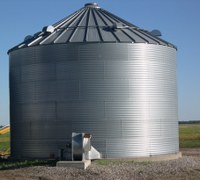Proper Spring Grain Drying and Storage Critical
(Click the image below to view a high-resolution image that can be downloaded)
As outdoor temperatures increase, stored grain requires attention to prevent losses, says Ken Hellevang, North Dakota State University Extension agricultural engineer and grain drying expert.
The stored grain temperature increases in the spring not only due to an increase in outdoor temperatures but also due to solar heat gain on the bin. Solar energy produces more than twice as much heat gain on the south wall of a bin in spring as it does during the summer.
Hellevang recommends periodically running aeration fans to keep the grain temperature near or below 30 degrees until the grain is dried if it exceeds recommended storage moisture contents, and below 40 degrees as long as possible during spring and early summer if the grain is dry. Night air temperatures are near or below 30 degrees in April and 40 degrees in May. Soybean oil quality may be affected in less than four months if even 12% moisture soybeans are stored at 70 degrees.
Cover the fan when it is not operating to prevent warm air from blowing into the bin and heating the stored grain. Hellevang also recommends ventilating the top of the bin to remove the solar heat gain that warms the grain. Provide air inlets near the eaves and exhausts near the peak or use a roof exhaust fan.
Bin vents can become blocked with frost and ice when the fan is operated at temperatures near or below freezing, which may lead to damage to the roof. Leave the fill and access door open as a pressure relief valve when operating the fan at temperatures near or below freezing.
Monitor Grain Moisture, Temperature
Stored grain should be monitored closely to detect any storage problems early, Hellevang advises. Grain temperature should be checked every two weeks during the spring and summer. Grain also should be examined for insect infestations.
Check the moisture content of stored grain to determine if it needs to be dried. Remember to verify that the moisture content measured by the meter has been adjusted for grain temperature.
In addition, remember that moisture measurements of grain at temperatures below about 40 degrees may not be accurate. Verify the accuracy of the measurement by warming the grain sample to room temperature in a sealed plastic bag before measuring the moisture content.
Corn needs to be dried to 13% to 14% moisture for summer storage to prevent spoilage. Soybeans should be dried to 11% to 12%, wheat to 13%, barley to 12% and oil sunflowers to 8%. The allowable storage time for 13% moisture soybeans is less than 100 days at 70 degrees.
Corn at moisture contents exceeding 21% and soybeans exceeding 15% should be dried in a high-temperature dryer because deterioration is rapid at warmer temperatures. For example, the allowable storage time of 22% moisture corn is about 190 days at 30 degrees but only 30 days at 50 degrees.
Recommended Airflow Rates and Maximum Air Drying Moisture Contents
Here are some drying recommendations:
- Corn - For natural air-drying, assure that the fan’s airflow rate is at least 1 cubic foot per minute per bushel (cfm/bu) and the initial corn moisture does not exceed 21%. Start the fan when the outdoor temperature averages about 40 degrees.
- Soybeans - Use an airflow rate of at least 1 cfm/bu to natural air-dry up to 15% to 16% moisture soybeans. Start the fan when the outdoor temperature averages about 40 degrees. Follow the manufacturer’s recommendation for high-temperature drying soybeans. Monitor the soybean quality and reduce the drying temperature if excessive cracking or splitting occurs. Reduce the fire hazard by keeping the soybeans flowing in the dryer. Pods and trash can become lodged and combustible. Frequently clean the dryer to remove anything that may impede flow. Constantly monitor the dryer when drying soybeans.
- Sunflowers - Natural air-drying for oil sunflowers requires an airflow rate of 0.75 cfm/bu for up to 15% moisture. The drying should start when outdoor temperatures average about 40 degrees.
- Wheat - Use an airflow rate of at least 0.75 cfm/bu to natural air-dry up to 17% moisture wheat. Start drying when the outside air temperature averages about 50 degrees.
- Barley - Use an airflow rate of at least 0.75 cfm/bu to natural air-dry up to 16% moisture barley.
“Remember that some of the allowable storage life was used during the fall before the grain was cooled to near or below freezing, so there is less time for spring drying before deterioration occurs,” Hellevang says. “This is particularly important for malting barley, where germination can be lost, so using a higher airflow rate to reduce the drying time is encouraged.”
Grain Stored in Grain Bags
Grain storage molds will grow and grain spoilage will occur in grain bags unless the grain is dry. Grain in the bags will be at average outdoor temperatures, so grain will deteriorate rapidly as outdoor temperatures increase unless it is at recommended summer storage moisture contents.
Grain bags that run east-west will have solar heating on the south side, which creates a temperature variation across the bag that will move moisture to the north side of the bag. Continue to monitor grain stored in bags frequently.
Work Safely
“Also, everyone needs to become aware of safety hazards associated with handling grain and to apply recommended safety practices,” Hellevang stresses. “More grain deaths occur during years with challenging conditions.”
NDSU Agriculture Communication - March 24, 2020
| Source: | Ken Hellevang, 701-231-7243, kenneth.hellevang@ndsu.edu |
|---|---|
| Editor: | Ellen Crawford, 701-231-5391, ellen.crawford@ndsu.edu |


